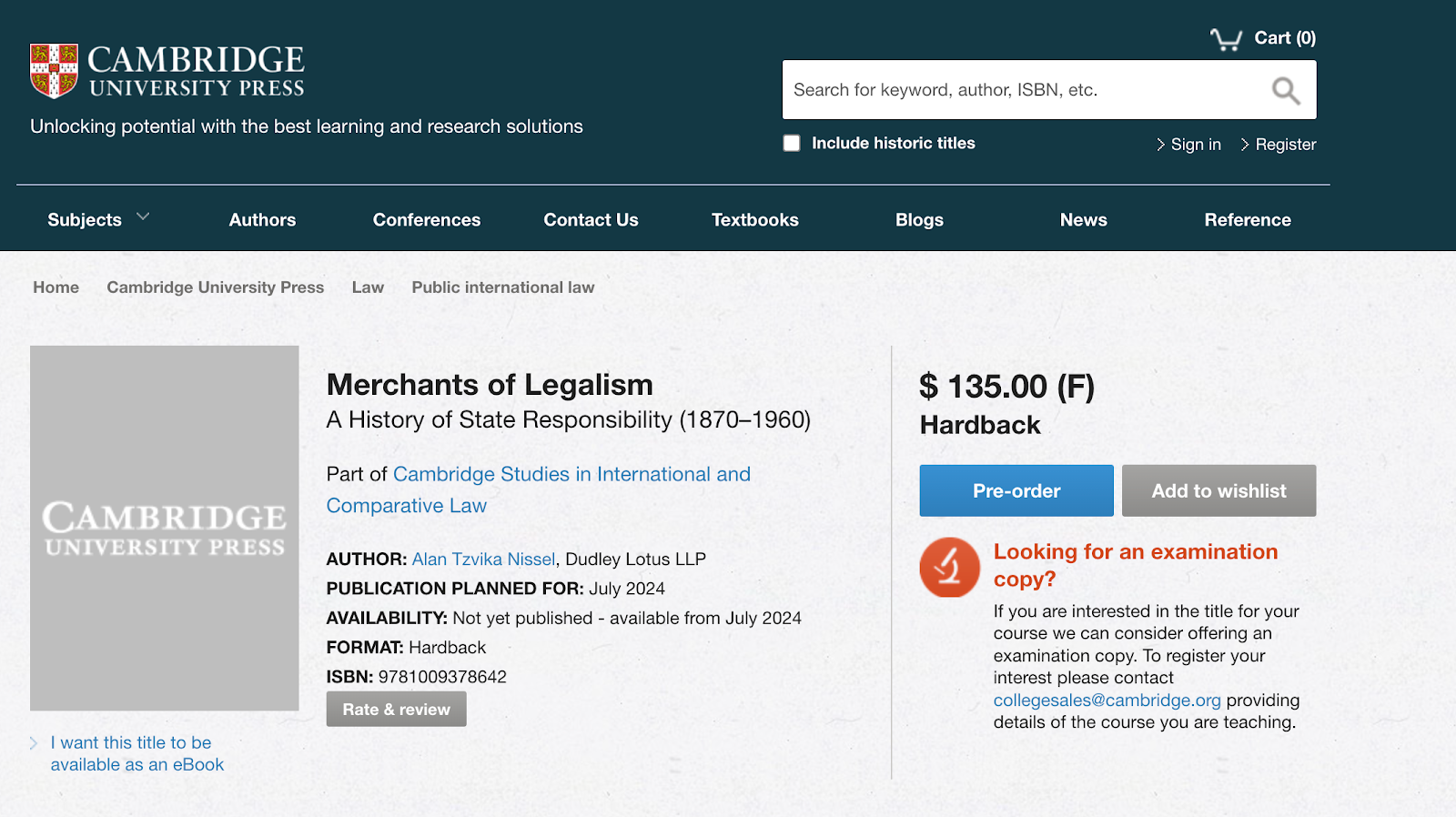Working DRAFT of Summary, Alan Tzvika Nissel, A History of State Responsibility
Summary of Project
In the first narrative, I describe State responsibility as the practice of alien protection. I locate the first usages of State responsibility in the diplomatic practice of the U.S. Government following its Civil War. U.S. nationals had flooded the State Department with claims for diplomatic protection. To resolve these claims efficiently with inconsiderable political or human resources, the State Department began delegating the resolution of these disputes to professional international arbitrators. From 1870 when Secretary Fish appointed Francis Lieber to umpire the first professional international tribunal, to 1899, when the Great Powers founded the Permanent Court of Arbitration, the U.S. lawyers firmly established international arbitration as the forum for resolving alien protection claims. The U.S. staffed these tribunals with likeminded lawyers who would base their awards on international rather than local standards of protection. The U.S. manner of litigating alien protection claims engendered a body of positive law. Although inchoate and often inconsistent, these awards began to articulate rules of liability regarding a State’s failure to meet international standards of alien protection.
In the second narrative, I describe State responsibility as the theory of international liability. In nineteenth century Germany, academic lawyers constructed theories of public law as part of their effort to make sense of recent political unification and strengthening governmental powers. August Wilhelm Heffter is often cited as the first to articulate principles of State liability (Haftung des Staates), but it was Georg Jellinek who offered its first theory (Selbstverpflichtungslehre). German public lawyers did not base their theories on international awards. To them, international arbitration did not produce law in the technical sense. They viewed liability under international law as an iteration of Sate liability under its domestic public law. In this way, inchoate international practice did not preclude them from articulating comprehensive theories on international liability since German lawyers could extrapolate them from their domestic legal experience. Notwithstanding the extent of this scholarship, the German theorization of State responsibility had a far greater impact upon lawyers in international institutions than in the Auswärtiges Amt.
In the third narrative, I explain how and why the U.N. codified State responsibility based on German theory rather than the U.S. practice. The U.N. had a choice to interpret its duty of codifying State responsibility narrowly as alien protection or broadly as a general code of international enforcement. On one level this was a question about the nature of international codification: should it be limited to past practice or should it provide a doctrine that addressed longer-term institutional needs? The question also pitted two groups of litigants – North and South Americans – against each other in the context of codification. Going into the Hague Codification Conference, U.S. diplomats were optimistic about limiting the codification of State responsibility to alien protection. However, it soon became clear that any bid to base the U.N.’s work on the U.S. practice amounted to codification suicide. Already by 1960, five attempts to codify State responsibility as alien protection had failed. Latin America lawyers had eventually accumulated sufficient voting power within international institutions to oppose efforts to entrench a practice that they viewed as imperialistic. A turning point came in 1961 under the leadership of Special Rapporteur Roberto Ago, who untethered the U.N.’s codification from past practice and set out to draft a general code of international enforcement. In contrast to German theory, however, Ago drafted the code to allow for specific regimes of practice to remain as exceptions to its rule. In this way, both North and South Americans could claim victory. The U.S. could maintain its arbitral practice of alien protection and the Latin Americans had secured a general code of international enforcement. For these reasons, the U.N. doctrine – successfully codified in 2001 – was an institutional reaction to and continuation of both the U.S. practice and Germany theory.
Finally, this project is more than a description of the past. It contains an argument about the relationship between the practice, theory and doctrine of State responsibility. I describe the development of State responsibility in terms of three phases. I do not, however, relate these periods in terms of historical progress (or regress). State responsibility appears differently depending on whether one is a practitioner, theorist or doctrinalist. There are moments in the history of State responsibility when one or other of these groups had more of an influence than others. But, what is also clear is that these groups are interdependent. The closer the interaction between practitioners, theorists and doctrinalists, the greater the influence of one on the other. The wider the gaps between practice, theory and doctrine, the greater international law’s exposure to criticism that ranges from apology to utopia. This study is my attempt to help re-associate the doctrine of State responsibility with its political and theoretical origins. My hope is that such efforts will contribute to a realignment of doctrine, theory and practice and, thus, to a strengthening of international law’s force.


Comments
Post a Comment